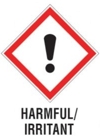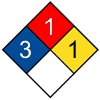| Safety Data Sheet | 115-3302 |
|
CircuitMedic, 22 Parkridge Road, Haverhill, MA 01835 USA Phone: 978-373-1600 | Website: www.circuitmedic.com CircuitMedic disclaims all liability associated with the use of this information. |
Revision Date: Nov 2, 2021 |
| Section 1. CHEMICAL PRODUCT AND COMPANY IDENTIFICATION | |
| Product Name: | Circuit Bond - Hardener |
| Product Number: | 115-3302 |
| Recommended use: | This is a general purpose adhesive that is packaged in a two-part plastic package. The components are mixed just prior to use. There are no identified uses advised against.
The components include: 115-3302 Circuit Bond - Resin http://www.circuitmedic.com/msds/msds_circuit_bond_resin.html 115-3302 Circuit Bond - Hardener http://www.circuitmedic.com/msds/msds_circuit_bond_hardener.html |
| Supplier: | CircuitMedic 22 Parkridge Road, Haverhill, MA 01835 USA PHONE: 978-373-1600, FAX: 978-372-5700 |
| Emergency Response: | For Chemical Emergency Spill, Leak, Fire, Exposure, or Accident Call CHEMTREC Day or Night Within USA and Canada: 1-800-424-9300 CCN4877 Outside USA and Canada: +1 703-527-3887 (collect calls accepted) |
| Section 2. HAZARD IDENTIFICATION | |||
| 2.1 Classification of the substance or mixture | |||
| Classification of the chemical in accordance with CFR 1910.1200(d)(f):
Conforms to Regulation (EC) No. 1907/2006 (REACH), Annex II, as amended by Commission Regulation (EU) 2015/830 |
|||
| Hazard pictograms: |
|
||
| Signal Words: | DANGER | ||
| GHS Class: |
Serious Eye Damage, category 1 Skin corrosion, category 1 Skin Sensitization, category 1 Specific Target Organ Toxicity - STOT, Single Exposure SE. Category 3 (Respiratory tract irritation). |
||
| Hazard Statements: |
H318 - Causes serious eye damage. H314 - Causes severe skin burns and eye damage. H317 - May cause an allergic skin reaction. H335 - May cause respiratory irritation. |
||
| Precautionary Statements: |
P260 - Do not breathe dust/fume/gas/mist/vapours/spray. P261 - Avoid breathing dust/fume/gas/mist/vapours/spray. P264 - Wash hands thoroughly after handling. P271 - Use only outdoors or in a well-ventilated area. P272 - Contaminated work clothing should not be allowed out of the workplace. P280 - Wear protective gloves/protective clothing/eye protection/face protection. P301+P330+P331 - IF SWALLOWED: Rinse mouth. Do NOT induce vomiting. P302+P352 - IF ON SKIN: Wash with plenty of soap and water. P303+P361+P353 - IF ON SKIN (or hair): Remove/Take off immediately all contaminated clothing. Rinse skin with water/shower. P304+P340 - IF INHALED: Remove victim to fresh air and keep at rest in a position comfortable for breathing. P305+P351+P338 - IF IN EYES: Rinse cautiously with water for several minutes. Remove contact lenses, if present and easy to do. Continue rinsing. P310 - Immediately call a POISON CENTER or doctor/physician. P312 - Call a POISON CENTER or doctor/physician if you feel unwell. P333+P313 - If skin irritation or rash occurs: Get medical advice/attention. P362+P364 - Take off contaminated clothing and wash it before reuse. P363 - Wash contaminated clothing before reuse. P403+P233 - Store in a well-ventilated place. Keep container tightly closed. P405 - Store locked up. P501 - Dispose of contents/container in accordance with Local, State, Federal and Provincial regulations. |
||
| Hazards not otherwise classified that have been identified during the classification process: | None known. | ||
| Section 3. COMPOSITION, INFORMATION OR INGREDIENTS | ||||
| Chemical/Ingredient Name | CAS Number | Ingredient Percent | EC Number | Comments |
| Diethylenetriamine | 111-40-0 | 10 - 30 | 203-865-4 | - |
| Epoxy polyamine adduct | Proprietary | 60 - 100 | - | - |
| Section 4. FIRST AID MEASURES | |
| 4.1 Description of first aid measures | |
| Eye Contact: | Immediately flush eyes with plenty of water for 15 to 20 minutes. Get medical attention, if irritation or symptoms of overexposure persists. |
| Skin Contact: | Immediately wash skin with plenty of soap and water for 15 to 20 minutes, while removing contaminated clothing and shoes. Get medical attention if irritation develops or persists. |
| Inhalation: | If inhaled, remove to fresh air. If not breathing, give artificial respiration or give oxygen by trained personnel. Seek immediate medical attention. |
| Ingestion: | If swallowed, do NOT induce vomiting. Call a physician or poison control center immediately. Never give anything by mouth to an unconscious person. |
| 4.2. Most important symptoms and effects, both acute and delayed | |
| None | |
| 4.3 Indication of any immediate medical attention and special treatment needed | |
| No additional information. | |
| Section 5. FIRE-FIGHTING MEASURES | |
| 5.1 Extinguishing media | |
| Extinguishing Media: | Use alcohol resistant foam, carbon dioxide, dry chemical, or water fog or spray when fighting fires involving this material. |
| Unsuitable Media: | None. |
| 5.2 Special hazards arising from the substance or mixture | |
| Hazardous Combustion Byproducts: | Oxides of carbon, aldehydes, amines, aniline, acids and other organic substances may be formed during combustion. The chemical nature and quantity of decomposition by-products will vary widely depending on the conditions of combustion. |
| Unusual Fire Hazards: | Sealed containers at elevated temperatures may rupture explosively and spread fire due to polymerization. |
| 5.3 Advice for firefighters | |
| Fire Fighting Instructions: | Evacuate area of unprotected personnel. Use cold water spray to cool fire exposed containers to minimize risk of rupture. Do not enter confined fire space without full protective gear. If possible, contain fire run-off water. |
| Protective Equipment: | As in any fire, wear Self-Contained Breathing Apparatus (SCBA), MSHA/NIOSH (approved or equivalent) and full protective gear. |
| NFPA Health: | 3 |
| NFPA Fire: | 1 |
| NFPA Reactivity: | 1 |
| Section 6. ACCIDENTAL RELEASE MEASURES | |
| 6.1 Personal precautions, protective equipment and emergency procedures | |
| Personnel Precautions: | Evacuate area and keep unnecessary and unprotected personnel from entering the spill area. Use proper personal protective equipment as listed in Section 8. |
| 6.2 Environmental precautions | |
| Environmental Precautions: | Avoid runoff into storm sewers, ditches, and waterways. |
| 6.3 Methods and material for containment and cleaning up | |
| Methods for Containment: | For small spills, activate available exhaust ventilation equipment in the immediate spill area. Wipe up or absorb spilled material with paper towels or other absorbent material. For large spills, dike area to contain spill. Take precautions as necessary to prevent contamination of ground and surface waters. |
| Methods for Cleanup: | For small spills, wash area with soapy water to remove residue. Collect absorbed material and water rinses in appropriate containers. Dispose of in accordance with Federal, State and local regulations. For large spills, recover spilled material on adsorbent, such as sawdust or vermiculite, and sweep into closed containers for disposal. After all visible traces, including ignitible vapors, have been removed thoroughly wet vacuum the area. If area of spill is porous, remove as much contaminated earth and gravel, etc. as necessary and place in closed containers for disposal. Do not flush to sewer. |
| Other Spill Precautions: | Spill response operations must be conducted in accordance with the provisions of OSHA 29 CFR 1910.120. Review the entire SDS before proceeding with spill response. |
| 6.4 Reference to other sections | |
| Use proper personal protective equipment as listed in Section 8. | |
| Section 7. HANDLING AND STORAGE | |
| 7.1 Precautions for safe handling | |
| Handling: | Use with adequate ventilation. Avoid breathing vapor, aerosol or mist. Avoid contact with eyes, skin, or clothing. Avoid prolonged or repeated contact with skin. Keep container tightly closed when not in use. |
| Special Handling: | Provide appropriate ventilation/respiratory protection against decomposition products (see Section 10) during welding/flame cutting operations and to protect against dust during sanding/grinding of cured product. |
| Hygiene Practices: | Use good personal hygiene practices. Wash hands before eating, drinking, smoking or using restroom facilities. Promptly remove contaminated clothing and launder thoroughly before reuse. |
| 7.2 Conditions for safe storage, including any incompatibilities | |
| Storage: | Store in a cool, dry, well ventilated area away from sources of heat and incompatible materials. Keep container tightly closed when not in use. Do not reuse empty containers. Keep out of the reach of children. |
| 7.3. Specific end use(s) | |
| No additional information. | |
| Section 8. EXPOSURE CONTROLS AND PERSONAL PROTECTION | |
| 8.1 Control parameters | |
| Exposure Guidelines | |
| Diethylenetriamine: | |
| ACGIH: | Skin:Skin |
| 8.2 Exposure controls | |
| Appropriate engineering controls | |
| Engineering Controls: | Use appropriate engineering control such as process enclosures, local exhaust ventilation, or other engineering controls to control airborne levels below recommended exposure limits. Good general ventilation should be sufficient to control airborne levels. Where such systems are not effective wear suitable personal protective equipment, which performs satisfactorily and meets OSHA or other recognized standards. Consult with local procedures for selection, training, inspection and maintenance of the personal protective equipment. |
| Individual protection measures | |
| Eye Protection: | Wear appropriate protective glasses or splash goggles as described by 29 CFR 1910.133, OSHA eye and face protection regulation, or the European standard EN 166. |
| Skin Protection: | Chemical-resistant gloves and chemical goggles, face-shield and synthetic apron or coveralls should be used to prevent contact with eyes, skin or clothing. |
| Respiratory Protection: | A NIOSH approved air-purifying respirator with an organic vapor cartridge or canister may be permissible under certain circumstances where airborne concentrations are expected to exceed exposure limits. Protection provided by air purifying respirators is limited. Use a positive pressure air supplied respirator if there is any potential for an uncontrolled release, exposure levels are not known, or any other circumstances where air purifying respirators may not provide adequate protection. A respiratory protection program that meets OSHA 1910.134 and ANSI Z88.2 requirements must be followed whenever workplace conditions warrant the use of respirators. |
| Other Protective: | Facilities storing or utilizing this material should be equipped with an eyewash facility and a safety shower. |
| Hygiene Practices: | Use good personal hygiene practices. Wash hands before eating, drinking, smoking or using restroom facilities. Promptly remove contaminated clothing and launder thoroughly before reuse. |
| Section 9. PHYSICAL AND CHEMICAL PROPERTIES | |
| 9.1 Information on basic physical and chemical properties | |
| Physical State: | Liquid. |
| Color: | Clear amber |
| Odor: | Amine like odor |
| pH: | Not determined. |
| Melting Temperature: | Not determined. |
| Boiling Temperature: | Greater than 374 °F |
| Flash Point: | Greater than 212 °F |
| Flash Point Method: | Not determined. |
| Ignition Temperature: | Not determined. |
| Lower Flammable Limit: | Not determined. |
| Vapor Pressure: | Not determined. |
| Vapor Density: | Not determined. |
| Solubility: | Not determined. |
| Specific Gravity: | (Ref: water = 1). |
| Evaporation Rate: | Not determined. |
| VOC Content: | Not determined. |
| Viscosity: | Not determined. |
| Odor Threshold: | Not determined. |
| 9.2 Other information | |
| None available. | |
| Section 10. STABILITY AND REACTIVITY | |
| 10.1 Reactivity | |
| Reactivity: | Stable under normal handling and storage conditions. |
| 10.2 Chemical Stability | |
| Chemical Stability: | Stable under normal temperatures and pressures. |
| 10.3 Possibility of hazardous reactions | |
| Hazardous Polymerization: | It will not vigorously polymerize, decompose, condense or not become self-reactive under conditions of shocks, pressure, or temperature. Uncontrolled mixing with resins may cause hazardous polymerization. |
| 10.4 Conditions To Avoid | |
| Conditions To Avoid: | Contact with acidic, basic, or oxidizing materials. Exposure to open flame or uncontrolled heat, uncontrolled mixing or exposure to incompatible substances. Avoid storage in open containers. |
| 10.5 Incompatible Materials | |
| Incompatible Materials: | Acidic, basic or oxidizing materials. |
| 10.6 Hazardous decomposition products | |
| None known. | |
| Section 11. TOXICOLOGICAL INFORMATION | |
| 11.1 Information on toxicological effects | |
| Diethylenetriamine: | |
| Skin Toxicity: | Administration onto the skin - Rabbit LD50 - Lethal dose, 50 percent kill: 1090 mg/kg [Details of toxic effects not reported other than lethal dose value](RTECS) |
| Ingestion Toxicity: | Oral - Rat LD50 - Lethal dose, 50 percent kill: 1080 mg/kg [Behavioral - Convulsions or effect on seizure threshold] (RTECS) |
| Inhalation Toxicity: | Inhalation - Rat LC50 - Lethal concentration, 50 percent kill: >0.07 - <0.3 mg/l (Supplier SDS) |
| Epoxy polyamine adduct: | |
| Ingestion Toxicity: | Oral - Rat LD50 - Lethal dose, 50 percent kill: 200 - 500 mg/kg (Manufacturer Studies) |
| Section 12. ECOLOGICAL INFORMATION | |
| 12.1 Toxicity | |
| Ecotoxicity: | No ecotoxicity data was found for the product. |
| 12.2 Persistence and degradability | |
| Environmental Fate: | No environmental information found for this product. |
| 12.3 Bioaccumulative potential | |
| No data available. | |
| 12.4 Mobility in soil | |
| No data available. | |
| ection 13. DISPOSAL CONSIDERATIONS | |
| 13.1 Waste treatment methods | |
| Waste Disposal: | Use standard landfill methods consistent with applicable Federal, State, Provincial
and local laws. Consult with the US EPA Guidelines listed in 40 CFR Part 261.3 for the classifications of hazardous waste prior to disposal. Furthermore, consult with your state and local waste requirements or guidelines, if applicable, to ensure compliance. Arrange disposal in accordance to the EPA and/or state and local guidelines.
Do not reuse, heat, burn, pressurize, cut, weld, braze, solder, drill, grind, expose to sparks, flame, or ignition sources of empty containers without proper commercial cleaning or reconditioning. |
| Section 14. TRANSPORT INFORMATION | |
| 14.1 UN Number: | UN2735 |
| 14.2 UN proper shipping name: | Amines, liquid, corrosive, n.o.s. (Diethylenetriamine) |
| 14.3. Transport hazard class(es): | 8 |
| 14.4 Packing group: | III |
| 14.5 Environmental hazards | Environmentally hazardous substance, liquid, n.o.s. |
| 14.6 Special precautions for user | None. |
| 14.7 Transport in bulk according to Annex II of Marpol and the IBC Code | Not applicable. |
| DOT Shipping Name: | Amines, liquid, corrosive, n.o.s. (Diethylenetriamine) |
| DOT UN Number: | UN2735 |
| DOT Hazard Class | 8 |
| DOT Packing Group: | III |
| IMDG Shipping Name: | Amines, liquid, corrosive, n.o.s. (Diethylenetriamine) |
| IMDG UN Number: | UN2735 |
| IMDG Hazard Class: | 8 |
| IMDG Packing Group: | III |
| IATA Shipping Name: | Amines, liquid, corrosive, n.o.s. (Diethylenetriamine) |
| IATA UN Number: | UN2735 |
| IATA Hazard Class: | III |
| IATA Subrisk: | 8 |
| Notes from Section 14: | The data provided in this section is for information only. Please apply the appropriate regulations to properly classify your shipment. This classification applies only to transportation classification and not the packaging, labeling, or marking requirements. The shipper is responsible for complying with all applicable laws and regulations, including proper transportation classification, packaging, and labeling. |
| Section 15. REGULATORY INFORMATION | |
| 15.1 Safety, health and environmental regulations/legislation specific for the substance or mixture | |
| EU legislation: | Regulation (EC) No 1272/2008 of the European Parliament and of the Council of 16
December 2008 on classification, labelling and packaging of substances and mixtures (as
amended). COMMISSION REGULATION (EU) 2015/830 of 28 May 2015 amending Regulation (EC) No 1907/2006 of the European Parliament and of the Council on the Registration, Evaluation, Authorisation and Restriction of Chemicals (REACH) |
| Regulatory - Ingredient Based: | |
| Diethylenetriamine: | |
| Canada DSL: | Listed |
| TSCA Inventory Status: | Listed |
| EC Number: | 203-865-4 |
| 15.2 Chemical safety assessment | |
| No data available. | |
| Section 16. OTHER INFORMATION | |||||||||
| HMIS: |
|
||||||||
| NFPA |
|
||||||||
To the best of our knowledge, the information contained herein is accurate.
However, neither Circuit Technology Center, Inc., nor any of its subsidiaries assumes any liability whatsoever for the accuracy or completeness of the information contained herein.
The final determination of the suitability of any material is the sole responsibility of the user.
All materials may present unknown hazards and should be used with caution. Although certain hazards are described herein, we cannot guarantee that these are the only hazards that exist.
| Safety Data Sheet | 115-3302 |
|
CircuitMedic, 22 Parkridge Road, Haverhill, MA 01835 USA Phone: 978-373-1600 | Website: www.circuitmedic.com CircuitMedic disclaims all liability associated with the use of this information. |
Revision Date: Nov 2, 2021 |


